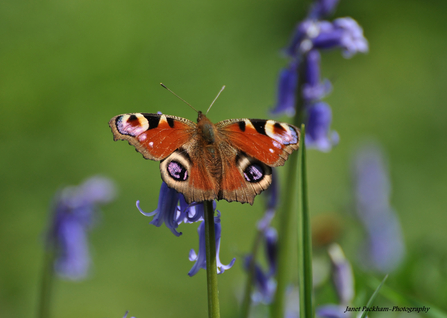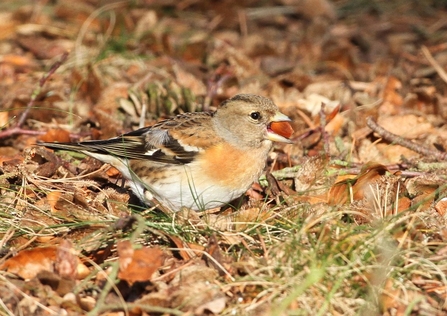It really feels like nature is waking up again now, we hope you’ve also been enjoying seeing early flowers like daffodils and bluebells and butterflies and bees that are visiting our green spaces once more. In our Priestcliffe Lees reserve cowslip, who’s name means cowpat; mountain pansy , the largest of our native pansies; and wood anemone, which is also known as Windflower were all recorded. Elsewhere one of our 250 solitary bee species, tawny mining bee, was seen, as were the iconic peacock and the aptly named orange tip butterflies. Close by a brimstone butterfly was spotted, its thought the male’s wings inspired the name butterfly due to their bright yellow colour.
Sightings Blog - 2022 Blog #7

Peacock butterfly, Janet Packham Photography
You’ve also recorded a host of bird species including near Hope Valley the wren, our most common breeding bird; the dunnock, whose females mate with two males so they both supply food to the chicks, and the great tit, whose female prefer males with a wider black stripe of their chest. Also seen were the coal tit, whose call sounds like a bicycle pump; the familiar robin, which is one of the few birds to sing all year in the UK; and the chaffinch of which there are approximately 6 million breeding pairs in the UK in the summer. Nearby a buzzard was seen as well, whose eggs take just over a month to hatch with clutches consisting of two to four eggs.
To the South near Buxton, a blackcap was recorded, these medium sized warblers are also known as the 'nightingales of the north' due to their beautiful song, as was a curlew, which is also famous for its haunting song from February through to July on its breeding grounds. Further south near Matlock a lapwing was seen, some of which go to the continent in spring to breed whilst others stay in the UK. Going even further south to Belper a brambling was seen, these small birds look almost identical to their close relative the chaffinch, which their often seen with, except for their white rump. And right in the south of Derbyshire a wood warbler, one of our summer visitors, and a chiffchaff, many of which migrate here from Africa to breed though some stay all year round.

(C) Margret Holland
Near Buxton there were many sightings of brown hares, whose females in a single year can produce over a dozen babies called leverets, as was a pair of 7-spot ladybirds, which is one of our most common ladybirds and who use their bright colours to warn predators that they don’t taste good. Finally in south Derbyshire there was a sighting of a smooth newt, also known as the common newt, which hibernate underground over winter.
We are looking forward to reading about your wildlife sightings across Derbyshire as we make our way through spring. To submit your own sighting and be featured in a future blog go to www.derbyshirewildlifetrust.org.uk/wildlife/record-sighting.
Thank you to Yvonne Foster, Anne Clark, Mike Johnson, Ken West, Carole Boon, Jenni Fellows, Chloe Gordon and Richard Knisely-Marpole for submitting their wildlife sightings.
